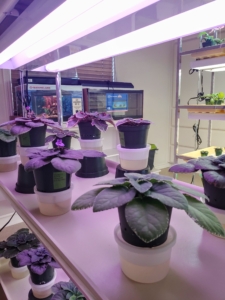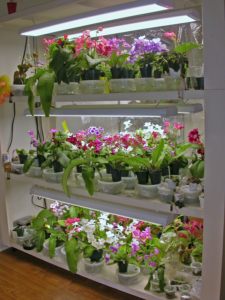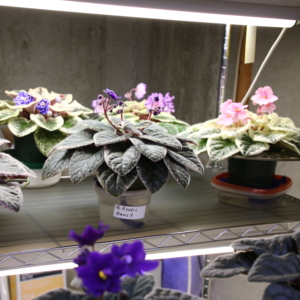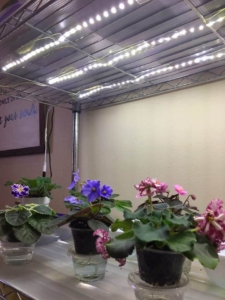
Steve’s violets growing under lights
There are numerous types of lights, fixtures, and stands. This article will focus on duration and spacing, specifically under artificial light. I grow using fluorescent lights, but I feel this approach applies to other light sources, too. It can be a great jumping-off point if you are working with LED, also.
Duration is critical; how long should your lights be running.? All my stands run for eight hours or less, depending on the type of tubes used. So, a T12 tube emits less light than a T8 or T5. I explain it this way, the smaller the tube diameter, the great the surface, so more light emitted. So, you may need to back down the total hours your lights are on if you’re using T8 or T5; T5 tubes emit more light than a T8 bulb so that will require even less time.
How will you know you’ve hit that sweet spot? Let the plants tell you. They will grow flat as a board. Their leaf stems aren’t wrapping around the pot, and the crowns aren’t distorted or tight. I recommend starting at 8 hours, and then watching the plants for 3-4 weeks; mark your calendar for the start date, and if your plants are still growing tight and not laying flat, reduce the time by 5-10 minutes. You will then mark your calendar again, and do so until most of your plants are growing perfectly flat. That’s your sweet spot on time. Make a note of the number of hours for each stand(s.)
What’s the proper distance from the light source to the plants? Well, again, the plants will tell you. I keep my light fixtures that are moveable to the top. In some cases, that means the spacing from top to bottom that is 36” +. Here’s why not every cultivar has the same lighting needs; some require more light while others want less light. I solve this issue by first growing ever plant on the shelve; if they are all growing good, I do nothing. If some are growing spindle and open, I know they want more light. So, it enters using risers. I place plants that are asking for more light on upside-down plastic flower pot(s). This approach gives way to growing many cultivars perfectly on one stand, yet meeting their individual lighting needs. You may need to move some African violets from the end to the middle of the light tubes. It’s a process of learning and letting each cultivar tell you their needs. Once a plant has its home, it states there.
Growing under artificial lights can be rewarding. I find the most significant light duration issues and spacing from the light source to the hardest to figure out. So, start at 8 hours, adjust accordingly, and then adjust one more time for each cultivars individual’s requirements. Let the plants tell you, they always do.
 Choosing the Best Light
Choosing the Best Light




 My main growing area is in an unfinished area of my basement. One of my challenges is keeping the area warm enough, so I rely on T12 fluorescent bulbs to provide extra warmth when the heater is not running. I use one cool white (5500K-6500K) and one warm white (3500K) bulb in each fixture. I change one bulb in each fixture every year, so all the bulbs are less than two years old. I run the lights for 10 hours per day (on a timer), as there is no natural light in the area.
My main growing area is in an unfinished area of my basement. One of my challenges is keeping the area warm enough, so I rely on T12 fluorescent bulbs to provide extra warmth when the heater is not running. I use one cool white (5500K-6500K) and one warm white (3500K) bulb in each fixture. I change one bulb in each fixture every year, so all the bulbs are less than two years old. I run the lights for 10 hours per day (on a timer), as there is no natural light in the area. More and more growers are saying goodbye to their fluorescent lights in exchange for the convenience of LED’s. LED lights use less electricity, last longer, and are more cost effective. They also use substantially less heat making them safer, and I’ve noticed I don’t get water spots on leaves.
More and more growers are saying goodbye to their fluorescent lights in exchange for the convenience of LED’s. LED lights use less electricity, last longer, and are more cost effective. They also use substantially less heat making them safer, and I’ve noticed I don’t get water spots on leaves.